Palmer Fab 5 – Hessian A-Class – Test Report by bonedo.de
The Palmer Fab 5 in the bonedo test – The boom of small tube amp in Class A technology is obviously still far from bottoming out, and there are hardly any manufacturers who do not want to be part of it. The developers of Palmer in the Hessian area of Neu Anspach want to present the FAB 5 All-Tube Guitar Combo, a nifty device that will be sure to beautify our dull autumn this year. 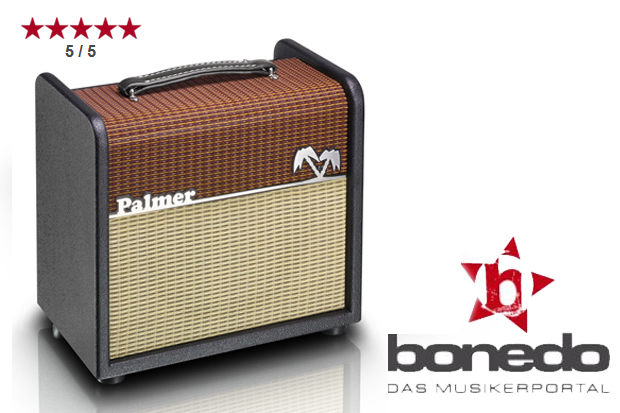 Knowing that various products within the brand have scored high marks in our previous tests, the expectations are understandably quite high. Can the Fab 5 actually follow in the footsteps of its siblings?
Knowing that various products within the brand have scored high marks in our previous tests, the expectations are understandably quite high. Can the Fab 5 actually follow in the footsteps of its siblings? 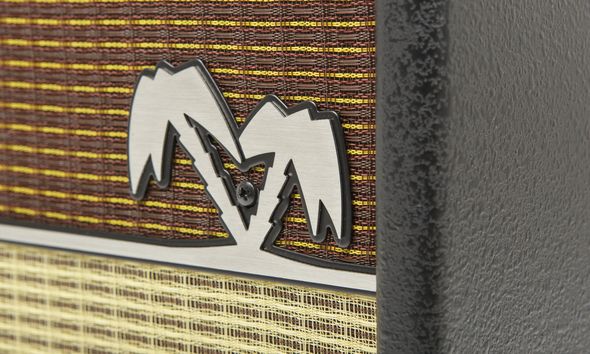 Details Housing / Aesthetics
Details Housing / Aesthetics
Already it earns a thumbs up for the visual impression, since the Fab 5 comes in a smart retro design with beige and light brown grille cloth, combined with a black-lacquered wooden cabinet. The whole thing doesn’t look as if it was hastily designed to suit the retro style of the ’50s, but instead has its own unique appearance, which certainly shows good taste. Then, we have the construction design where for Palmer everything just seems to fall into place: official components, all switches and controls are of a high quality and will no doubt perform faithfully for many years. The amp provides five watts of amplifier power and the sound transmission originates from the inside of the closed housing of a 10″ Ragin Cajun speaker from Eminence. A 12AX7 in the prepress stage and a 6V6 in the amplifier account for the Class A tubes’ power. An EZ81 serves as a rectifier tube. Of course, such a massively built tube amp, as compact as it is, is bound to come with a small disadvantage: The box is no lightweight! Or, to put it rather more positively, it is a bit too small for its weight. With dimensions of 360 x 345 x 230 mm it weighs a juicy 10 kilos, but is still comfortable to carry with the faux leather handle on the top. Four large rubber feet provide a non-slip grip.
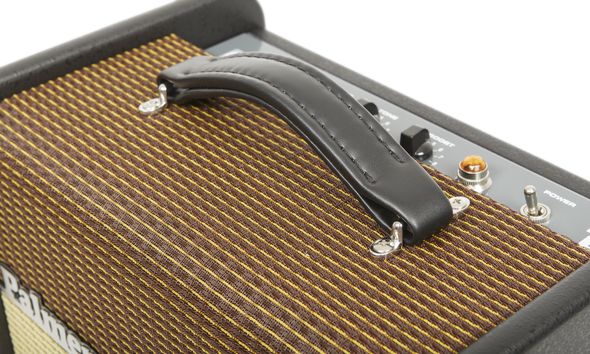
Control Panel The Fab 5 is operated from above (Toploader), which is the most practical solution, given its size. In addition to the power switch, on the grey-painted panel you’ll also find a large status LED, an input jack and three control knobs for volume, tone and boost. 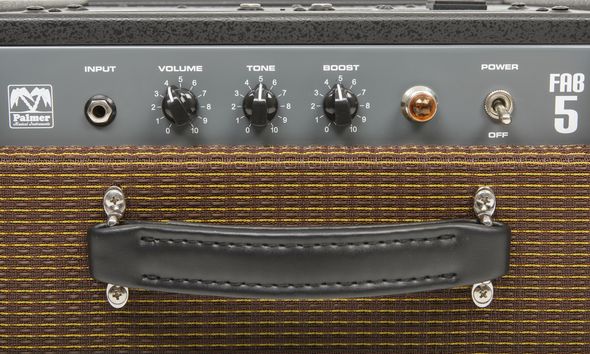 The final volume is regulated with the volume control. At higher settings, there is also the potential for slight distortion sounds.
The final volume is regulated with the volume control. At higher settings, there is also the potential for slight distortion sounds. 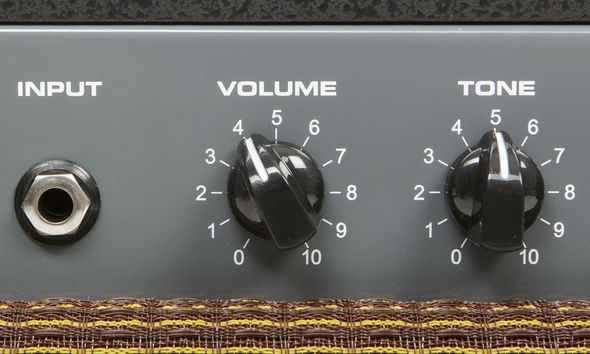 If you would like to hear more, turn the boost control to emphasise the distortion and volume. The tone control, which is a trebleblend, determines the sound.
If you would like to hear more, turn the boost control to emphasise the distortion and volume. The tone control, which is a trebleblend, determines the sound. 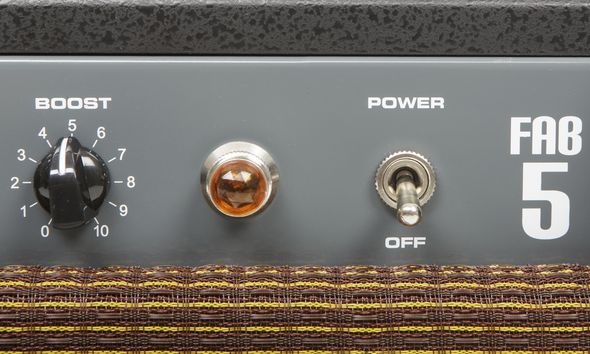 Back Panel The boost function is normally active. It can, however, be switched on and off with a standard footswitch (not supplied) – the connection can be found on the back. It is also possible to set a rather undistorted sound for rhythm sections and to add some serious bite to the solo distortions by activating the boost. You may also connect an external speaker (8 ohms) on the back panel. However, by doing this, the internal speaker is muted. The Fab 5 has a Powersoak function, to adjust the performance in three stages, and here too, the developers have been very practical and make direct recommendations on how best to use the amp: full, room and bedroom are clearly labelled and for some of us, are easier to understand than simple wattage indications;-).
Back Panel The boost function is normally active. It can, however, be switched on and off with a standard footswitch (not supplied) – the connection can be found on the back. It is also possible to set a rather undistorted sound for rhythm sections and to add some serious bite to the solo distortions by activating the boost. You may also connect an external speaker (8 ohms) on the back panel. However, by doing this, the internal speaker is muted. The Fab 5 has a Powersoak function, to adjust the performance in three stages, and here too, the developers have been very practical and make direct recommendations on how best to use the amp: full, room and bedroom are clearly labelled and for some of us, are easier to understand than simple wattage indications;-). 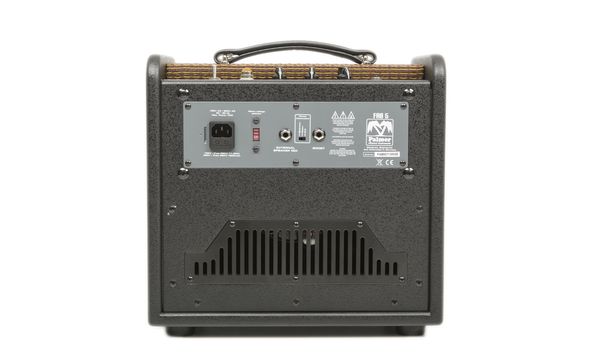
 Operating the Fab5 The amp is very easy to operate with its three control knobs, which means that there is no real need to refer to the operator’s manual. I would recommend that you take a look, however, since there are a few key things about Class A circuits and rectifier tubes worth reading.
Operating the Fab5 The amp is very easy to operate with its three control knobs, which means that there is no real need to refer to the operator’s manual. I would recommend that you take a look, however, since there are a few key things about Class A circuits and rectifier tubes worth reading.
As we now know, a 5 Watt-Amp can generate a rich sound pressure and this seems to be the case with the Fab 5: At full power, the little roaring cube can accommodate a quiet band rehearsal. The clean reserves do not go beyond the upper room volume. With a single coil guitar, you can get a clean tone with the boost turned off and the volume at 12 o’clock; after that, it becomes pleasantly filthy. Here, firstly the undistorted sound with the strat.
Music sample below: http://www.bonedo.de/artikel/einzelansicht/palmer-fab-5-test/2.html
Important: the information on the knob settings correspond to the numbers on the control panel (0 to 10):
Clean The amp has a very good direct response, and even the dynamic range is quite broad. You can vary the way you strike the strings on the guitar, and the amplifier will follow you at every step of the way. To some extent, this can be heard in the previous example; with distorted sound, however, it is even more obvious. I played the next chord progression in four stages: Firstly, I played delicately with my thumb, then lightly with the pick close to the neck. Next, I moved the pick closer to the bridge and strummed there lightly; finally, I struck harder in same position. Any change in the sound is clearly recognisable.
Dyna Pick The maximum drag with a single coil guitar can be heard in the next example. For this, I turned up the volume and boost to the full extent. The result: the Fab5 rocks as expected.
Max Gain Strat Now we turn our attention to the Humbucker guitars, the Les Paul is unpacked and with the same settings, the following sound can be heard from the speaker:
Max Gain Les Paul The amp shows a crisp amp distortion with a good compression behaviour. This is the more brutal end of the flagpole : MidGain Sounds with good Sustain and clear lead suitability. By combining the boost and volume, you can bring out the various facets of distortion sounds. And this is what the Fab5 does particularly well. The power amplifier pops at higher volume settings, whilst crunch sounds get on very well at a lower volume and higher boost. Here are two examples with different volume boost settings.
Overdrive 1
Overdrive 2 The tone control allows for more fine-tuning, but no extreme sound settings that would go against the character and the concept of the amp. It is subtle and musically to the point; the sound is softer, but not stuffy, when the tone knob is fully turned off. At the other extreme, when the tone knob is turned to the right, it produces clear highs, without being biting. To my ear, this is a truly homogeneous setting. This is also the case for the overall sound, which is very balanced across the frequency range. 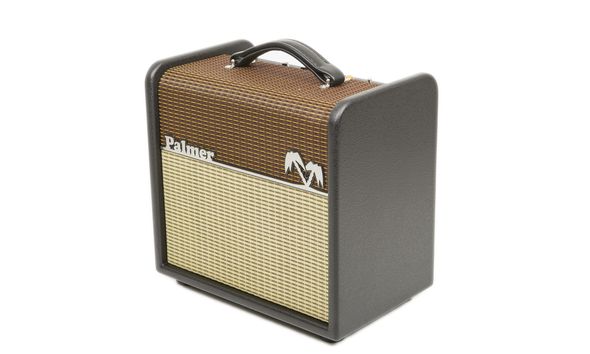
Conclusion
The Palmer Fab 5 is worthy of its name and therefore also earns all five stars. The reason for this is down to the whole package, which you can purchase for less than 500 Euros. The amp is solid and uses official components, which guarantee a long lifetime. The five watts produce considerable power so that it can even be used for a decent rehearsal. Anyone who wants to enjoy the amp distortion at home, can choke the performance from full power to lounge or bedroom volume. Sound, response and dynamic behaviour are excellent and overdrive gourmets get their money’s worth: from the lightly distorted pitch to the mid gain board, there is quite a bit of potential. Furthermore, the three control knobs allow for very fine gradations in the sound setting, and the boost function can even be accessed via a foot switch. Both as a practice and as a studioamp it makes the grade, and when connected to a larger box, it offers a little more oomph.
Pros
Sound
Fine adjustment of the overdrive sounds
Design
Components dynamics
Response
Power attenuator
Sound pressure level
Cons
–
Complete product information is available here:
http://www.palmer-germany.com/mi/en/FAB-5-5W-All-Tube-Guitar-Combo-PFAB5.htm
Source: www.bonedo.de, Germany
Author: Thomas Dill
Leave a Comment
You must be logged in to post a comment.












